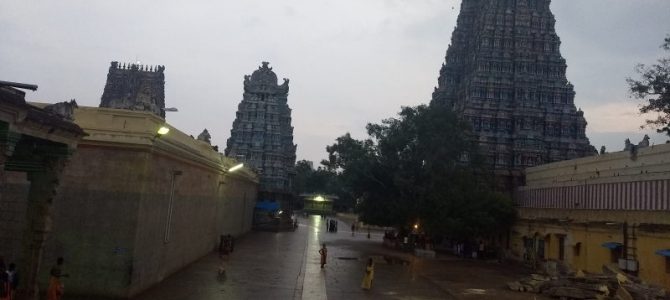Long before the start of Indus Valley civilisation and the establishment of the Aryan race in India, the land to the south of the Vindhya mountains, which we we now call peninsular India or colloquially as south India, was inhabited by the Dravidians. The time origin of Dravidian history is unknown, but the Tamil language is one of the oldest continuously used languages in the world. While major ancient languages like Latin and Sanskrit have no confirmed native speakers today, Tamil continues to be used although now it is in modern form. At the centre of Tamil culture and also right in the centre of the state of Tamil Nadu is the city of Madurai.
Situated by the banks of the Vaigai river and with the four gopuras of the Meenakshi Amman temple dominating the skyline, Madurai is one of the oldest continuously habitated and functioning cities in the world. No one really knows for sure how old the city is. Madurai was supposedly the home town of the three ancient Tamil Sangams or a period of generation of scholars who worked on literature. The original works from the first and second Sangams that predates Aryan history have been lost. The stories of the third Sangam are available to us today. The oldest stories about Madurai may actually be lost in history since the technology of documentation was scarce and unreliable.
History of Madurai
As mentioned in the introduction, it is virtually impossible to ascertain how old Madurai is. Recorded history goes back to around 500 BC. Continuous documentation exists only from 6th century BC, when the Meenakshi Amman temple was built. Several travellers from Rome, Arabia and Greece have documented the city in their stories. Madurai has passed several hands in terms of monarchy. At different times, the city was ruled by one Dravidian empire after another. The Pandians, Cholans, Vijayanagara and the Nayakas were the major Dravidian / Hindu rulers. Madurai was ruled by a Sultanate in the 14th century mainly under Jalaluddin Ahsan Khan before being defeated by Vijayanagara. The Nayakas were the last Indian-origin rulers of Madurai. They were actually an off-shoot of the Krishna Devaraya’s Vijayanagara empire. Under the Pandians, Cholans and the Nayakas, the city got several temples, ponds and religious centres. Madurai is a religious hub in Tamil Nadu with as many as 6 major temples and hundreds of small ones.
After the Nayakas, the British took over and developed the city as a major education and textile hub. The southern railway was built to connect the city to the port city of Chennai. Several colleges such as the Madural Law College and Lady Doak became centres for learning. Textile mills like Madura coats and mechanical engineering giants like JK Fenner were started in Madurai by the British. These industries thrived long after the British left and were responsible for employment of thousands of residents from Madurai and the surrounding hamlets. The textile mills lasted until the textile boom, while the mechanical giants decided to move to more modern cities due to persistent union trouble. Large scale industries in urban Madurai died a slow death. But the legacy of Madurai as a heritage city and as a pilgrimage is still going strong and is in no mood to slow down.
Geography of Madurai
Madurai is at the centre of the Tamil Nadu state. It is situated by the banks of the Vaigai river. While the entire district is plain, there are a few small hills around the city, the major ones being Thirupparankundram, Pazhamudhir Cholai and Nagamalai. However, within 100 km from Madurai, we reach the mountainous district of Theni. The popular hill station, Kodaikkanal in Dindigul district, is also less than 150 km away. The western Ghats, with popular getaways like Munnar, Idukki and Thekkadi, which are actually towns in the nearby state of Kerala, are closer to Madurai than to the big cities in Kerala such as Kozhikode, Kochi or Thiruvananthapuram. The weather of Madurai is hot, dry and arid. It is advisable to visit the city only during the cooler days in December – January.
Here are some of the best places to see in Madurai. Madurai is a fairly big city and we cannot have an exhaustive list. A list of 50 must-see places in Madurai will actually resemble a pilgrimage!
Thirumalai Nayakar palace
During the oppulent rule of the Nayaka dynasty in Madurai, the most famous and flamboyant of the Nayakas, Thirumalai Nayaka, built a monstrous edifice for himself. With an open courtyard and several rooms, the palace dwarfed the most important landmark of Madurai, i.e. the Meenakshi temple. The palace is actually less than two kilometres from the temple’s south gate.
While still majestic, the palace we see today is a ruin. After the decline of the Nayakas, parts of the palace were pulled down and the stones used to build structures on the main road around the area. Realising the state of neglect, the palace was declared as a protected monument after independence. The palace we see today is 1/4 th of the size of the original palace, with the several bedrooms gone. The main courtyard, darbar and some of the royal enclosures remain. Just outside the palace is a small museum of various stone deities found around Tamil Nadu.
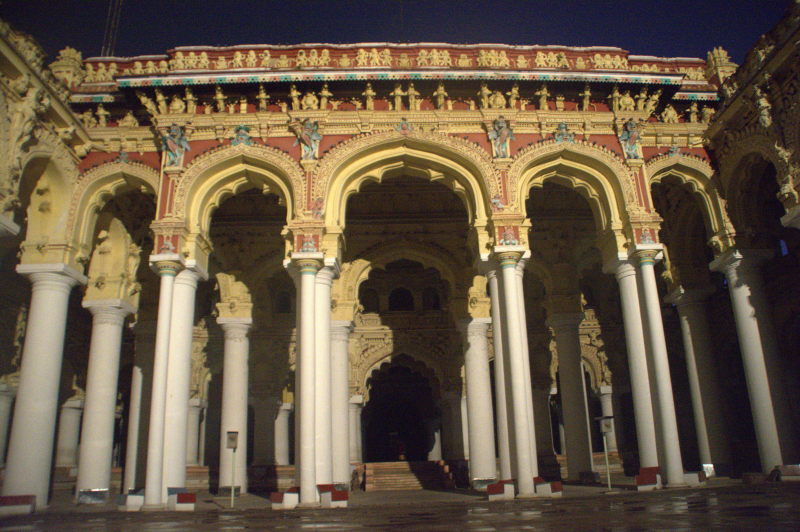
Thirumalai Nayak palace during its sound and light show.
The main attraction of the Thirumalai Nayaka palace is the sound and light show that happens in the evening. An English show is followed by a Tamil show. If you are non-Tamil, you have no option but to watch the English show. But if you are Tamil, I urge you to forgo the English show and watch the Tamil one instead. The voice-over in medieval-style Tamil, coupled by the high-quality light and sound effects lends an air of authenticity, transporting you to the 14th century. The English version is good, but it is too odd to hear Krishna Devaraya and the Nayakas talk to each other in Shakespearan English! To give you an idea, how would you feel if you were to hear Chhatrapati Shivaji speaking to the Mawals or Akbar speaking to Birbal in verses like, ‘Thou shalt come to me in twilight’ ?! 🙂
Meenakshi Amman temple
The continuously recorded history of the city starts with the construction of the Meenakshi Amman temple. The temple is dedicated to the marriage of Parvati in the form of Meenakshi Devi. Her consort, Lord Shiva, is known here by the name of Sundareshwara. The temple is also referred to as the Meenakshi – Sundareshwara temple. The highlight of the temple are the four tall gopuras, one if each direction, north, west, south and east. During our childhood (1990s), all the gopuras could be used as entrances and exits. However due to the increased tourism and for security control, temple entrance in now restricted to the south gopura, while the other gopuras can be used for exit. In the sanctum sanctorum, the main dome is made of pure gold and you can look at the dome from inside the temple by peering into a sight-view in the ceiling. At the centre of the temple complex is a pond that is named the Theppakkulam. There are a few famous statues on the walls of the temple. One shows Lord Vishnu placing his sister’s hands in the hands of Lord Shiva to welcome Him to the family in the form of marriage. Another one shows a mysterious creature that has the head of a man, but the body of an animal. This statue is called the Purushamriga.
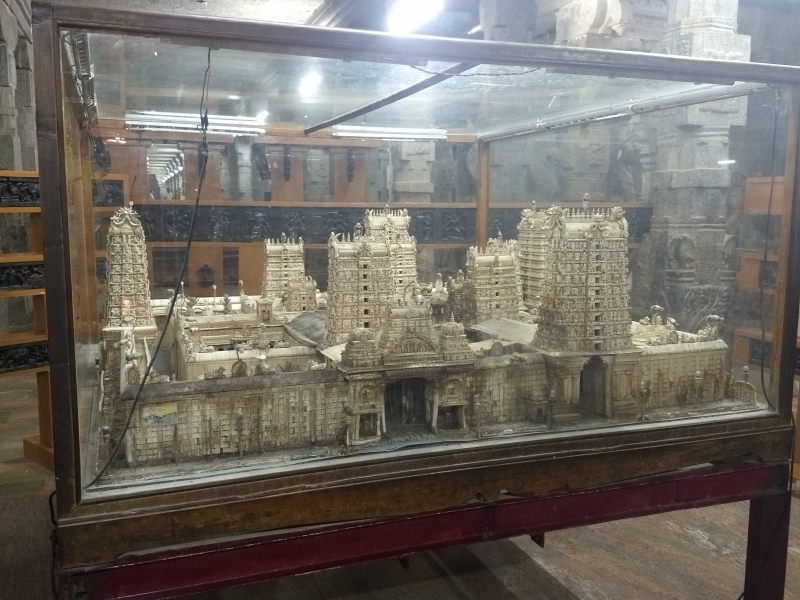
A model of Meenakshi temple campus
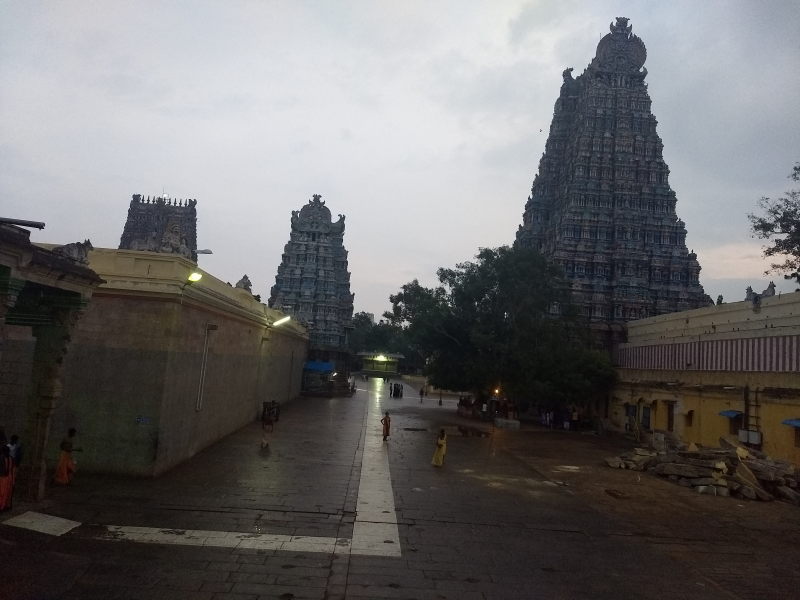
The gopuras of Meenakshi temple.

Meenakshi-Sundareshwara wedding, as Lord Vishnu gives his sister’s hand in marriage.
The temple also has a museum that shows the history of the temple, the Nayakas, the Pandians and the Cholans. Lord Shiva is known to have played several games with his devotees by appearing in front of them in several disguises and giving them tests to see how devoted they were to Him. These stories are collectively known as Thiruvilayadal (or the Game of the Divine). Several Thiruvilayadal stories are represented on the historice pieces in the museum in the form of illustrated panels in murals, similar to the way we read comics on paper today.
Pazhamudhir Cholai temple
At the top of a small hill at the north-eastern corner of Madurai is the temple of Pazhamudhir Cholai. A famous story about Lord Murugan and his aged poet devotee, Avayyar, is supposed to have happened here. The hill is a forest area, but in those days, these forests were supposed to be a haven of several varieties of fruits. Lord Murugan was sitting on a tree in the disguise of a young boy waiting for his aged, but melodious devotee to appear looking for Him. When she approached, the boy asked here to rest and offered to pluck fruits for her, but with the strange question, “Do you want the fruits served hot or cold?” “What kind of question is this?”, asked Avayyar. To this, the boy shook the tree vigorously, causing some of the fruits to fall to the ground. He then told Avayyar to pick and have some. Avayyar, seeing that the fruits were dusty, started blowing on them, to which the boy remarked, “Are the fruits so hot that you are having to blow on them?” Avayyar realised that the boy was Lord Murugan in disguise and upto His usual youthful mischief.
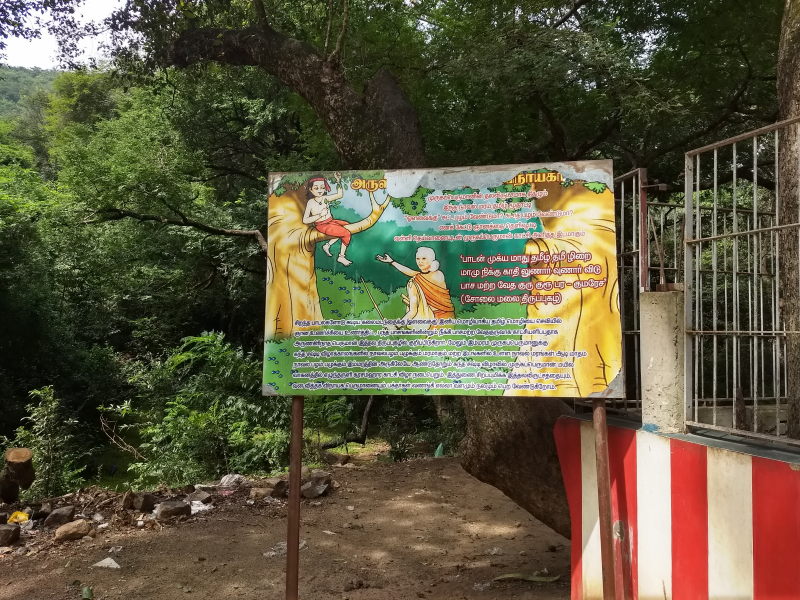
The story of Lord Murugan and Avayyar at Pazhamudhir Cholai.
The Pazhamudhir Cholai temple is one among the six temples known as Aruppadai Veedu or the six abodes of the Lord Murugan. Two of them are around Madurai.
Thirupparankundram
The second of the two Aruppadai Veedus is in the south-western suburb of Thirupparankundram. Just like Pazhamudhir Cholai, this temple is also at the top of a hill. A fleet of stairs takes you to the top. The stairs start near a huge man-made temple pond. To one side of the pond is the main bus terminal of Thirupparankundram.
Also at the peak of the hill is the Dargah of Hazrat Sultan Sikandar Badushah. It is locally referred to as the Thirupparankundram Dargah.
Other major temples
This blog post is about Madurai city and cannot sufficiently cover all the major temples of Madurai, along with their history. For that I promise you another post, since it is worthwhile. For now I will just list the other major temples and their chief deities.
Koodal Azhagar temple: is the most important temple in Madurai for Lord Vishnu and his consort, Lakshmi Devi in the form of Madhuravalli.
Kallazhagar temple: is another important temple worshipping Lord Vishnu. It is on the base of the hill which has Pazhamudhir Cholai temple. Tourists usually visit the two temples in the same commute, taking half a day away from Madurai city. The temple is surrounded by the ruins of an ancient fort.
Vandiyur Mariamman temple: is a temple dedicated to the deity of rain or the angry Devi, equivalent to Durga, Kali or Shitaladevi. The temple is situated in the Vandiyur locality and has a huge temple pond that is connected to the Vaigai river via a system of surface and underground canals.
Gandhi Museum
Near the campus of Madurai’s district collector’s office is the Gandhi memorial museum. Gandhiji is said to have donned his famous loin cloth in the city of Madurai. On this way to Madurai by train, he saw that people were wearing western dresses. He asked some people to adopt the Indian-made khadi, but the people replied that they didn’t have the money to buy any fabric, Indian or Western, and that the ones they were wearing on the train were actually the discards from their British employers. The harsh reality of poverty struck Gandhiji and he decided to stop wearing fineries of khadi and instead started wrapping himself in a single long khadi loin.
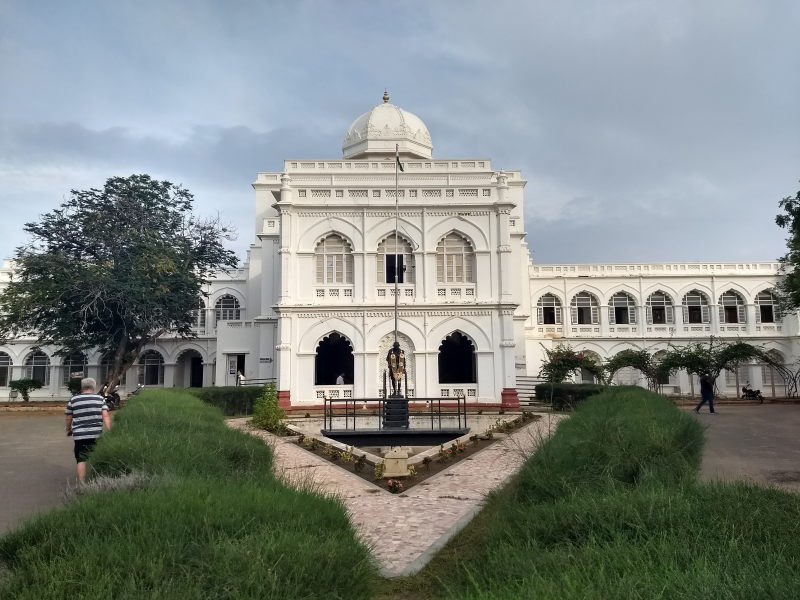
Gandhi museum
Also excellently portrayed in the museum is a 30-frame story of India’s colonialisation, the fight for freedom and eventual victory. No history book has done such justice or captivated the story in such a succinct, but powerful way.
Jallikattu
To the south of Madurai is the village of Alanganallur, which was mired in controversy during the Pongal of 2017. It is in this village where the now infamous and banned Jallikattu bull sport happens. Angry and confused bulls are released onto the streets of the village and the participants are encouraged to ride on the bull and hold it by its horns. The goal of the game is to tame the bull by showing your supremacy and by using the right body language. Injuries and deaths happen every year. Despite a strict ban by the supreme court, Jallikattu still happens discretely at Alanganallur and you may be lucky (or petrified) to catch one happen if you visit during Pongal.
What to eat / drink
Jigarthanda
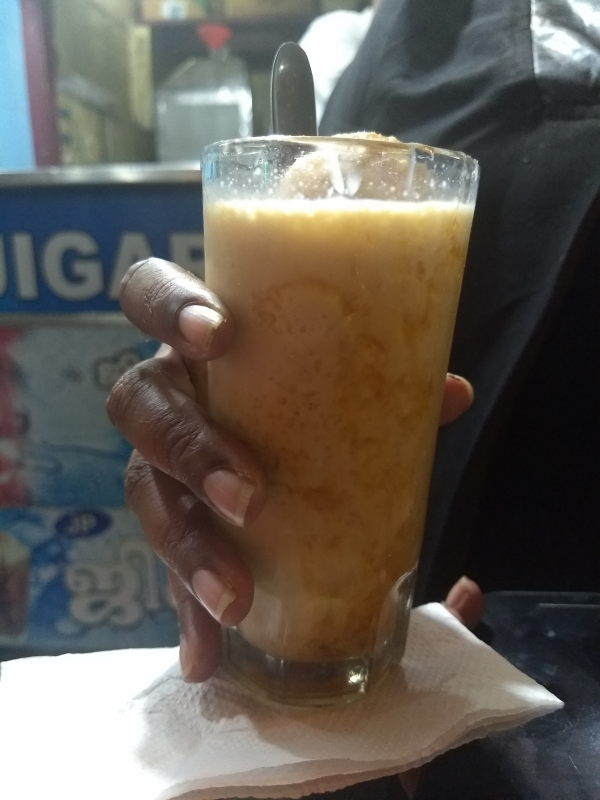
A glass of Jigarthanda is extremely refreshing in the Madurai heat.
Jigarthanda is actually a comibination of Hindi words, Jigar and Thanda, literally meaning a liver-cooling beverage. It is a form of cold drink local to Madurai, but now available all over Tamil Nadu. It’s made of milk, dry fruits, nuts, agar agar (a sea weed) and added flavouring. The best places to have Jigarthanda are outside the Meenakshi temple or at one of the outlets outside Madurai railway station and Periyar bus terminal.
Halwa
Prem Vilas Halwa is a shop that sells Halwa similar to the one made in Thirunelveli (more on that in a post about Thirunelveli). You can also get similar delicious Halwa in the street to the south of the Meenakshi temple, named the South Mada street.
Street-side Parota
Layered Parota is a delicacy in several cities in Tamil Nadu, but if you are peckish at 2 am in the middle of the night in Madurai, then the city will welcome you to one of the several street-side Parota stalls. You will find them mostly near the station, bus terminal or on the roads adjoining large scale factories and mills, when night-shift workers come out for supper.
New Arya Bhavan
New Arya Bhavan is a hotel founded by a north Indian, Bishambar Dayal Gupta, a businessman in Madurai during the 1950s. The hotel is excellent for tucking into authentic south Indian meals at an economical rate. They also have the concept of unlimited meals.
Other souvenirs
The jasmine flower sold in Madurai, especially outside the temples is pleasantly fragrant and is quite famous. It is known by the name of Madurai Malligai or simply Madurai Malli. If you are a woman, deck up your hair with a gajra (a small garland worn on the head) of Madurai Malli when you visit the temples of Madurai.
Getting to Madurai
Madurai has an airport with connections from important cities such as New Delhi, Mumbai, Chennai, Bengaluru, Hyderabad, Thiruvananthapuram, Kochi and Kolkata.
Madurai is a division headquarter in the Southern Railway zone of Indian Railways. It is an important railway junction on the Chennai – Villupuram – Thiruchi – Madurai – Thirunelveli – Kanyakumari route. It is also an important must-halt junction for all trains that are destined to the Rameshwaram and the famous Pamban bridge. This includes the newly introduced Ramayan express. There is a superfast train to New Delhi in the form of Sampark Kranti express.
There are several state buses from Chennai, Coimbatore, Trichy, Rameshwaram, Dindigul, Thirunelveli, Sivakasi and Thenkasi. Inter-state buses are in the form of Tamil Nadu and Kerala transport buses running between the two states. The main Kerala cities covered are Thiruvananthapuram, Kottayam and Munnar.
Madurai is a city on the Grand Southern Trunk highway, called GST for short, and designated with the code NH-47 or the Chennai – Kanyakumari highway. Important cities on this highway are Chennai, Villupuram, Kumbakkonam, Thanjavur, Trichy, Madurai, Thirumangalam, Thirunelveli and Nagercoil. You can join at any of the listed cities to take the highway to Madurai.
Conclusion
Is it the austerity of the ancient temples or the grandeur of the Thirumalai Nayaka palace? Is it the rich taste of Jigarthanda or the captivating fragrance of jasmines? Is it the melodious tune of the devotional songs playing in nearly every street right from 4 am in the morning or is it the sound of utensils from the Parota vendors late at night? Madurai is sure to leave you charmed for a long time.

